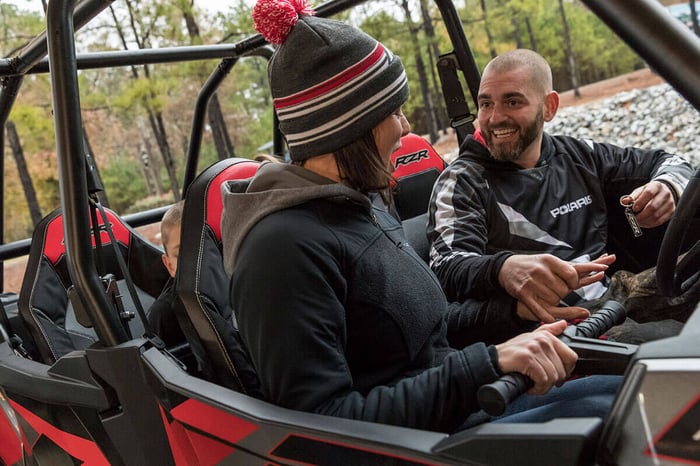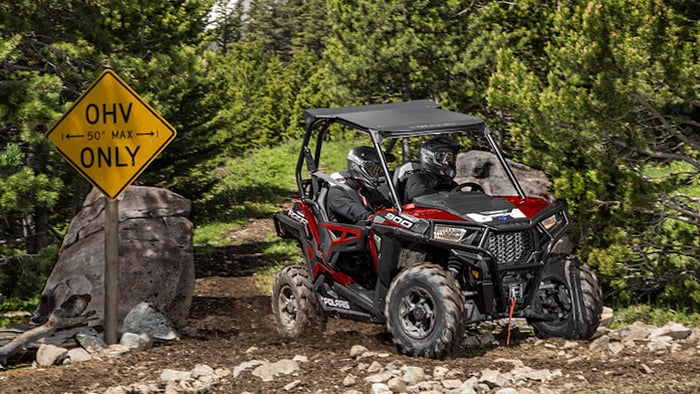You'd think by now Polaris Industries (PII -0.27%) would have figured out what the problem is with its all-terrain vehicles. Yet after two years of recalls affecting some 450,000 vehicles in almost every line it makes, and repeated assurances that it had a handle on the issue, apparently, the manufacturer still has no clue why its powersports vehicles are catching on fire.
Last week, the company and the Consumer Products Safety Commission (CPSC) issued a joint statement declaring that not only were certain Polaris vehicles (RZR 900 and 1000) liable to combust, but that some ATVs that had been recalled and repaired had later ignited, sometimes resulting in the total loss of the vehicle.

Image source: Polaris Industries.
Raging out of control
The problems with Polaris' RZR off-road vehicles began to attract notice in 2015 after a 15-year-old was killed when her ATV overturned and caught fire. The powersports vehicle maker recalled tens of thousands of RZRs to fix the problem, but soon the flaw began showing up in other vehicles; eventually, the company was issuing recalls almost every other week.
Those recalls all were to correct what Polaris termed "thermal hazards," a nice euphemism for the surprising tendency of RZRs, Rangers, Turbos, Generals, Slingshots, and snowmobiles to spontaneously combust. At this point, Polaris has found it necessary to recall some vehicles two or three times in its attempts to fix the problem, but as its recent statement with the CPSC reveals, that apparently hasn't been enough.
Specifically, the Polaris' RZR 900 and RZR 1000 models are still at risk of setting themselves aflame. That risk includes not just vehicles that were recalled in April 2016, but all of those produced for the 2013 to 2017 model years.
Curiously, the joint statement didn't announce another recall, but merely warned the riding public that even if they'd gotten their vehicle fixed or bought one recently, they could still experience the problem.
Moreover, the notice didn't include the don't ride/don't sell statement that has typically been part of previous announcements, requesting that dealers not sell the vehicles and owners not ride them until they're repaired. Maybe that's just seen as futile at this point.
Willful ignorance
While Polaris' stock is about 15% below where it peaked back in 2015, it's actually almost 70% higher than the low point it hit in early 2016. Shares had lost about 50% of their value in six months' time, but most of that was attributable to earnings and lowered profit expectations rather than the recalls. It seemed the persistent fire hazard had little impact.

Image source: Polaris Industries.
Consumers also seem willing to ignore the issue: In Q3, Polaris Industries reported "especially strong" RZR sales, and its best quarter for ATV sales in two years.
It's probably also fortunate for Polaris that one of its primary rivals, Arctic Cat, was acquired by Textron, which admits that the integration of its new unit hasn't gone as smoothly as anticipated, although it is still looking for the purchase to be accretive to earnings in 2018.
While multiline dealers could have stocked up on Arctic Cats or Textron Off Road vehicles (which segment Arctic Cat will eventually be folded into) had the RZR problem spiraled out of control, that apparently hasn't happened.
All is forgiven?
It will be interesting to see just how much longer investors and riders are willing to forgive Polaris Industries for its blundering response to its fire hazard problem. In 2016, the recalls sent warranty costs soaring 165% to $195 million; cut gross profit by $233 million -- with a 250-basis-point hit to gross margins -- and pushed operating expenses up 20%, or $141.6 million, mostly due to legal costs.
It hasn't gotten any better in 2017. Year to date, warranty claims paid are up 36% to $111 million, and the company faces several class action lawsuits over the hazards and its handling of the recalls.
RZRs remain far and away the most popular off-road vehicle -- Polaris' biggest product in its most important segment. Its failure to resolve their fire hazards may eventually take a toll on sales.
Though management has thrown tens of millions of dollars at the problem, appointed people to oversee its correction, and suggested that it had put it in the rearview mirror, it's clear Polaris does not have a handle on the situation. Investors are still staring at this problem as an obstruction on the road ahead, and at some point, they just may hit the brakes.


